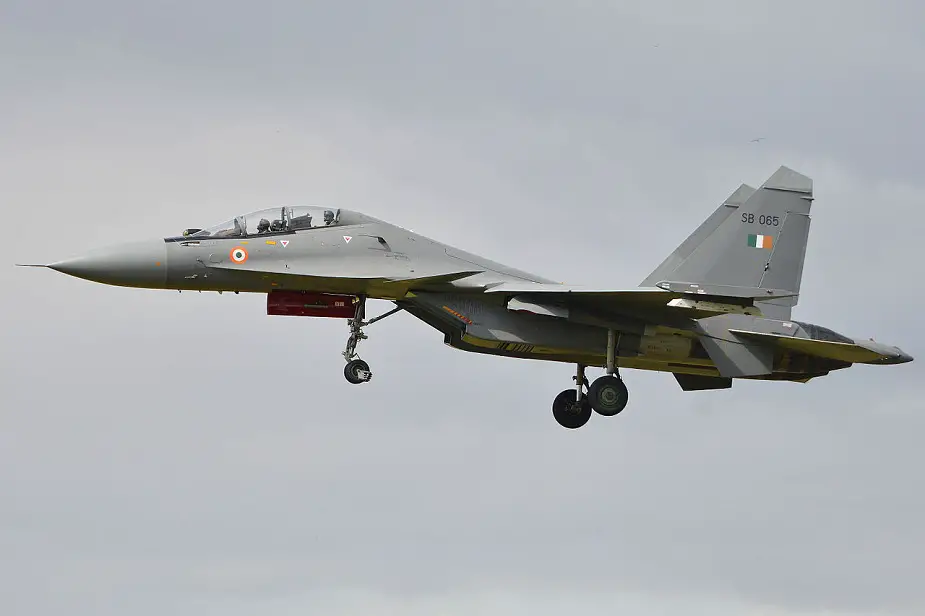Analysis: India plans to upgrade its Su-30MKI fighters
The Indian Air Force (IAF) is planning to upgrade its Sukhoi Su-30MKI multirole combat aircraft to a cutting-edge standard, according to local media outlets.
 An Indian Air Force Su-30MKI (Picture source: Alan Wilson)
An Indian Air Force Su-30MKI (Picture source: Alan Wilson)
During a press conference held on October 4, IAF Air Chief Marshal Rakesh Kumar Singh Bhaduria announced a plan to modernize the military service’s Sukhoi fighters. "In near future, the Sukhois [Su-30MKIs] will be upgraded in order to have their operational capabilities enhanced," said Bhadauria, adding that the upgraded air platform would get new avionics, onboard radar (possibly, one fitted with an active electronically scanned array (AESA)), and electronic warfare (EW) suite. At the same time, the IAF commander provided neither details on the modernization of the Su-30MKI no any time schedules.
The IAF now operates 12 Su-30MKI squadrons comprising 22-23 aircraft each; the number of units will have been increased to 14 by 2032. In his speech, Bhadauria mentioned an intention to acquire 12 more Su-30MKIs under urgent operational requirements. The IAF has fielded 272 Sukhoi aircraft, of which some 10 were lost in various accidents.
The Indian Ministry of Defense (MoD) places a specific emphasis on the modernization of the IAF. The military service still flies Mikoyan-Gurevich MiG-21 (though, in an upgraded configuration designated Bison) and MiG-27ML fighter jets, which have been dropped out of the actual catalogue of their designer, Russian Aircraft Corporation MiG (a subsidiary of the United Aircraft Corporation). The IAF is reported to scrap one MiG-27 unit and five MiG-21 squadrons by 2024; those units are to be followed by five squadrons of SEPECAT Jaguar fighter-bombers.
According to the IAF, the baseline twin-seat twin-engine Su-30MKI has a speed of 2,500 km/h (or Mach 2.35) and carries an 8,000 kg payload on external hardpoints. The platform’s armament suite incorporates a 30 mm Gryasev-Shipunov automatic gun and short-/medium-range air-to-air missile with radar or infrared seekers. India’s largest aircraft manufacturer, the concern Hindustan Aeronautics Limited (HAL) is now fitting some 40 Su-30MKIs with the BRAHMOS-A (A for Air-launched) air-launched cruise missile; India is also planning to develop a new variant of the BRAHMOS designated BRAHMOS-NG (NG for New Generation) for the MiG-29 and Su-30MKI multirole combat aircraft.
HAL is also planning to promote the upgraded Su-30MKI in the global market. "There is a market outside. We are already the only ones doing overhauls for the aircraft and once we conduct the upgrade, we can offer a better solution to the outside world as well," HAL Chairman Shri Madhavan told the Economic Times in mid-October. However, any promotion of the upgraded Su-30MKI without Russian permission and/or involvement can hardly take any place.
According to the web-channel Indian Defence Updates (IDU), the modernized Su-30MKI is unlikely to incorporate a new airframe. "The most radical Super Sukhoi upgrade for India’s fleet of Su-30 fighter jets will make changes to its airframe to reduce radar cross-section. The main drawback of this option is the high cost and long time it would take to introduce the changes. The most realistic option is to replace its passive phased-array radar with an AESA radar and integrate latest Russian- and Indian-made electronics, optics and infrared systems without [introduction of] modifications to the airframe," said the IDU, citing unspecified "top military experts".
The IAF is also pitching for an air warfare concept, which combines the Su-30MKIs and newly acquired 36 Rafale multirole combat aircraft under a single umbrella. In accordance with this idea, the Su-30MKI will remain the military service’s workhorse, while the Rafales will be operated by the most experienced pilots. The implementation of the concept will result in drastic increases of logistic support costs; the operating of Su-30MKI, which is produced under license and overhauled by HAL, is the most cost-effective approach to securing India’s skies.
© Copyright 2019 TASS. All rights reserved. This material may not be published, broadcast, rewritten or redistributed.


























